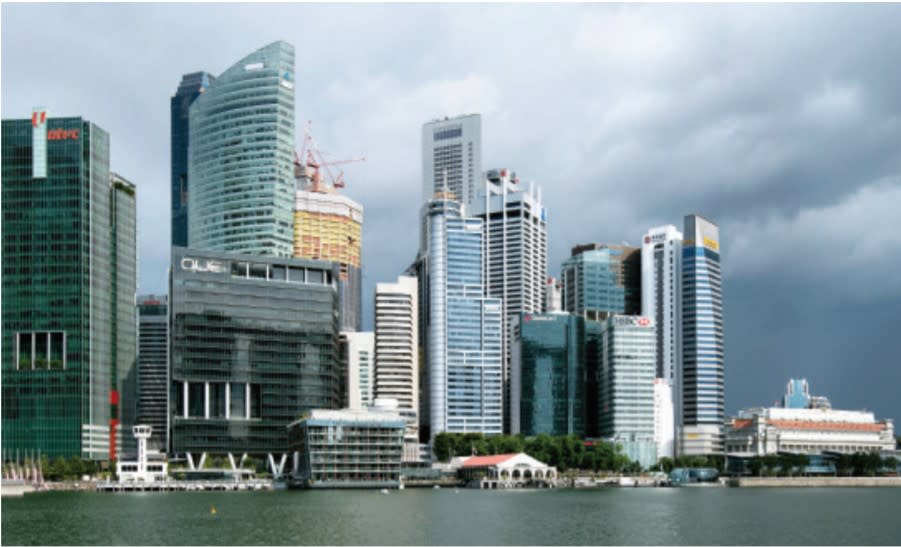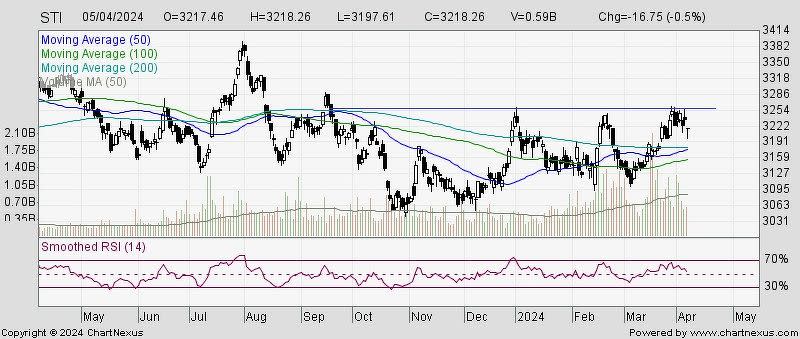Consolidation phase for Straits Times Index, S&P500 set to continue

Both the STI and S&P500 are likely to consolidate further following minor signs of stress in price patterns
As at April 5, the Straits Times Index has been unable to break above the 3,250 level on its third attempt this year. Instead, the index has retreated, albeit down just 6 points week-on-week. On the candlestick chart, a shooting star coupled with a hangman suggests further consoldiation. Although the most meaningful support appears at 3,100, the decline could halt initially at around 3,170. This is the potential meeting place, later this month, of the rising 50-day moving average and the declining 200-day moving average
Note that the STI was unable to follow the S&P500 to new highs earlier this year. As a result, the decline and corrective phase could also be relatively shallow.
The S&P500 itself is likely to experience a deeper correction following the break below an accelerated uptrend. The S&P500 touched a high of 5,254 on March 28 before retreating. Even if it falls to 5,000 from its current level of 5.147, its long term uptrend would remain intact.
Despite market volatiliy, risk-free rates did not move much. The yield on 10-year US treasuries settled at 4.31%, and it may ease towards 4.20%
It is not surprising that US equity markets are somewhat volatile. Federal Reserve governors are giving either conflicting or non-statements on the outlook for interest rates.
According to US media reports, Minneapolis Federal Reserve President Neel Kashkari called the January and February inflation readings “a little bit concerning”. He said “in March I had jotted down two rate cuts this year if inflation continues to fall back towards our 2% target. If we continue to see inflation moving sideways, then that would make me question whether we needed to do those rate cuts at all”.
Philadelphia Fed President Patrick Harker said inflation remains too high, even as the economy has been resilient and job growth remains strong.
Meanwhile, Cleveland Fed President Loretta Mester said “I did anticipate that we’ll see inflation moving down and now we need to see more evidence that confirms that. And once I see that, then I think we’re in a position to move interest rates down”.
Chicago Fed President Austan Goolsbee said that higher-than-expected inflation readings in January and February likely don’t change the broader picture of cooling price growth. However, he added that “based on market data on rents for new leases, I have been expecting it to come down more quickly than it has. If it does not come down, we will have a very difficult time getting overall inflation back to the 2% target”.
Richmond Fed President Thomas Barkin said it is “smart” for the Fed to take time to gain greater clarity about the inflation trajectory before lowering interest rates. He said “given a strong labour market, we have time for the clouds to clear before beginning the process of toggling rates down”. He added that “I am optimistic that keeping rates somewhat restrictive can bring inflation back to our target”.
The Fed Funds Futures is pricing in a 60% chance of a 25bp rate cut by June, a total of 29bp cut by July and 74bp by year-end.

See Also:
Click here to stay updated with the Latest Business & Investment News in Singapore
Temporary pause for STI, S&P 500 as they encounter resistance
Get in-depth insights from our expert contributors, and dive into financial and economic trends

 Yahoo Finance
Yahoo Finance 